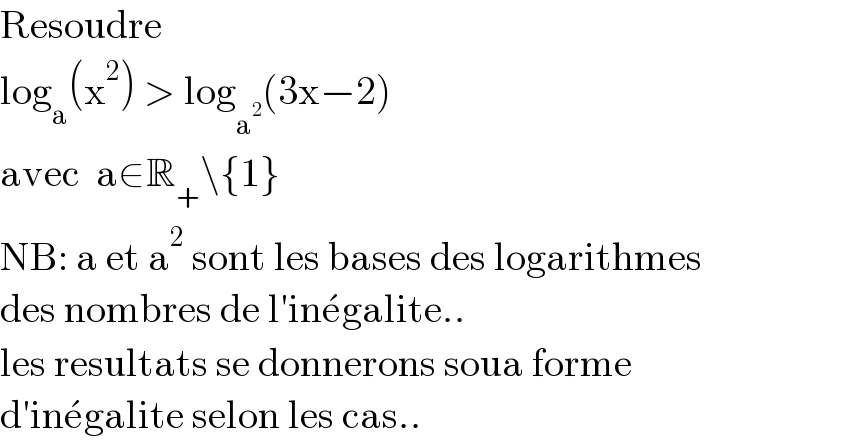
Question and Answers Forum
Question Number 147714 by puissant last updated on 22/Jul/21

Answered by Olaf_Thorendsen last updated on 22/Jul/21
;α] : x−1 < 0 et x^3 +x^2 +x−2 ≤ 0 (2) est impossible. −Si x∈]α;1[ : x−1 < 0 et x^3 +x^2 +x−2 > 0 (2) est verifiee. −Si x∈[1;+∞[ : x−1 ≥ 0 et x^3 +x^2 +x−2 > 0 (2) est impossible. Finalement, S = ]α;1[ si a∈]0;1[ •2eme cas : a > 1, lna > 0 L′inegalite devient : (x−1)(x^3 +x^2 +x−2) > 0 (3) et S = ](2/3);α[∪]1;+∞[ si a∈]1;+∞[](Q147720.png)
Commented bypuissant last updated on 22/Jul/21

| ||
Question and Answers Forum | ||
Question Number 147714 by puissant last updated on 22/Jul/21 | ||
 | ||
Answered by Olaf_Thorendsen last updated on 22/Jul/21 | ||
;α] : x−1 < 0 et x^3 +x^2 +x−2 ≤ 0 (2) est impossible. −Si x∈]α;1[ : x−1 < 0 et x^3 +x^2 +x−2 > 0 (2) est verifiee. −Si x∈[1;+∞[ : x−1 ≥ 0 et x^3 +x^2 +x−2 > 0 (2) est impossible. Finalement, S = ]α;1[ si a∈]0;1[ •2eme cas : a > 1, lna > 0 L′inegalite devient : (x−1)(x^3 +x^2 +x−2) > 0 (3) et S = ](2/3);α[∪]1;+∞[ si a∈]1;+∞[](Q147720.png) | ||
| ||
Commented bypuissant last updated on 22/Jul/21 | ||
 | ||